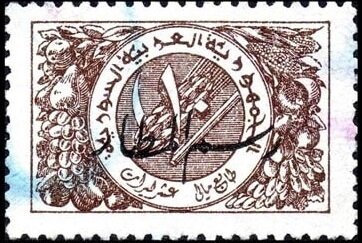Stamp: Scythe and fruit (Syria 1977)
Scythe and fruit (Syria 1977)
01 January (Syria ) within release Airport Tax goes into circulation Stamp Scythe and fruit face value 10 Syrian pound
| Stamp Scythe and fruit in catalogues | |
|---|---|
| Colnect codes: | Col: SY A1977-02 |
Stamp is square format.
Fiscal stamp with a one-line "Airport Tax" Arabic overprint in black With patterned security underprint Revenue Reverend cat. no: A65Also in the issue Airport Tax:
- Stamp - Scythe and fruit face value 10;
- Stamp - Horse and goat face value 5;
|
Data entry completed
60%
|
|
|---|---|
| Stamp Scythe and fruit in digits | |
| Country: | Syria |
| Date: | 1977-01-01 |
| Paper: | ordinary |
| Perforation: | comb 11½ x 12 |
| Emission: | Revenue |
| Format: | Stamp |
| Face Value: | 10 Syrian pound |
Stamp Scythe and fruit it reflects the thematic directions:
Agriculture is the cultivation and breeding of animals, plants and fungi for food, fiber, biofuel, medicinal plants and other products used to sustain and enhance human life.[1] Agriculture was the key development in the rise of sedentary human civilization, whereby farming of domesticated species created food surpluses that nurtured the development of civilization. The study of agriculture is known as agricultural science. The history of agriculture dates back thousands of years, and its development has been driven and defined by greatly different climates, cultures, and technologies. Industrial agriculture based on large-scale monoculture farming has become the dominant agricultural methodology.
An airport is an aerodrome with extended facilities, mostly for commercial air transport. Airports usually consist of a landing area, which comprises an aerially accessible open space including at least one operationally active surface such as a runway for a plane to take off and to land or a helipad
In botany, a fruit is the seed-bearing structure in flowering plants (also known as angiosperms) formed from the ovary after flowering. Fruits are the means by which angiosperms disseminate seeds. Edible fruits, in particular, have propagated with the movements of humans and animals in a symbiotic relationship as a means for seed dispersal and nutrition; in fact, humans and many animals have become dependent on fruits as a source of food. Accordingly, fruits account for a substantial fraction of the world's agricultural output, and some (such as the apple and the pomegranate) have acquired extensive cultural and symbolic meanings. In common language usage, "fruit" normally means the fleshy seed-associated structures of a plant that are sweet or sour, and edible in the raw state, such as apples, bananas, grapes, lemons, oranges, and strawberries. On the other hand, in botanical usage, "fruit" includes many structures that are not commonly called "fruits", such as bean pods, corn kernels, tomatoes, and wheat grains. The section of a fungus that produces spores is also called a fruiting body.
Flora is the plant life occurring in a particular region or time, generally the naturally occurring or indigenous—native plant life. The corresponding term for animal life is fauna. Flora, fauna and other forms of life such as fungi are collectively referred to as biota. Sometimes bacteria and fungi are also referred to as flora, as in the terms gut flora or skin flora.




